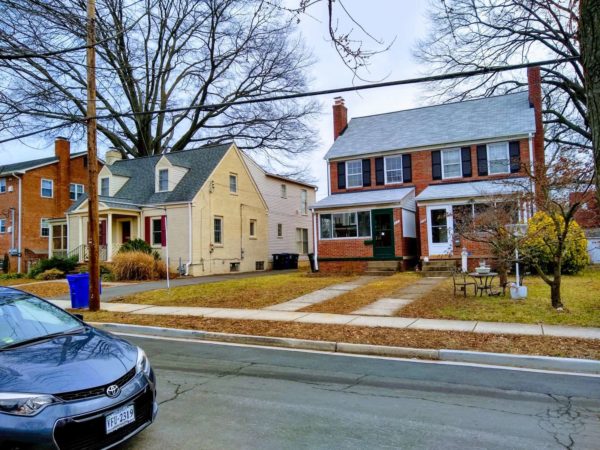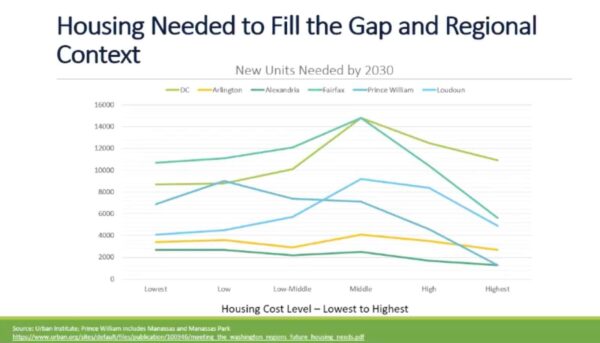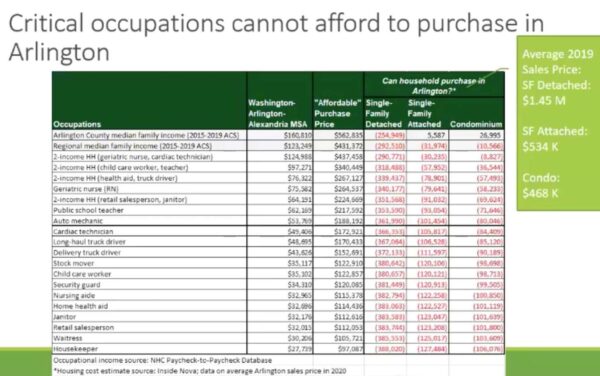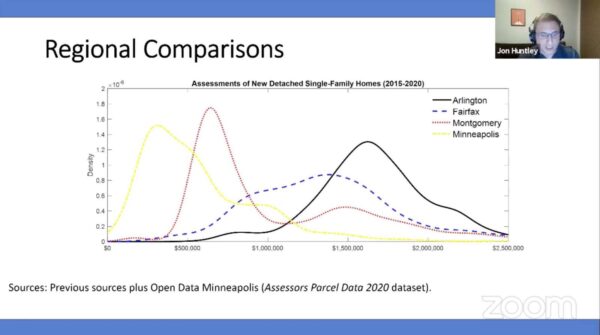Arlington’s lack of affordable townhomes, duplexes and other housing types has a ripple effect across the D.C. region, housing experts say.
How Arlington tackles that deficit, they said, could help stem the tide of urban sprawl and its social, economic and environmental impacts — with more options, lower- and middle-income households are better able to stay in their communities, be near their jobs and access established transit areas.
“Leadership [in Arlington] is still needed,” said Michael Spotts, President of Neighborhood Fundamentals, during a recent Arlington Committee of 100 webinar on Missing Middle Housing. “This is an important issue and Arlington can’t solve it on its own, but it’s something that we should do because it’s good for the county and the region.”
With the multi-year “Missing Middle Housing Study,” Arlington County is examining whether the county should allow housing types that have been typically prohibited from many neighborhoods to reverse housing shortages. If approved, rewritten ordinances would not be implemented until 2022 or 2023.
The county recently published the results of six months of community engagement. Priorities include a greater supply and wider array of housing options, at lower costs, while concerns include the impact that would have on property values, school capacity and the environment.
Now, the county is asking people what kinds of housing options should be explored. Through June 8, respondents can choose from 10 options, including multiplexes, cottage clusters, townhouses and small-lot homes currently excluded from some neighborhoods.
Providing those options locally will help address a regionwide problem that panelists say is currently driving urban sprawl, which is harming the environment.
“We’ve seen more development in outlying counties, and significant losses in impervious surface,” Spotts said. “We are downstream from some of these locations and that has an impact on Arlington’s environment. By limiting development [here], we may be able to save trees but at the expense of much larger acreage of forest loss in other jurisdictions.”
It also contributes to higher greenhouse gas emissions in those outlying counties, since many drive to work in Arlington and D.C., he said.
With the average costs of homes in Arlington ranging from $500,000-$1.5 million, depending on type, that prices out many professions like teachers, mechanics, security guards and so on.
Instead, they go where the average price is lower than in Arlington, said Jon Huntley, a senior economist at the Penn Wharton Budget Model who also runs the website Arlington Analytics.
High land costs set a minimum price for any new Missing Middle construction, however, and more stock may not solve the affordability problem anytime soon given Arlington’s housing shortage, according to Huntley.
“The prices of new Missing Middle properties will have to reflect that alternative [to build very expensive single-family detached homes],” he said.
Since 2017, Huntley said Arlington has built 58 brand-new townhomes with an average selling price of $1 million. There were only eight duplexes built — for an average price of $1 million — and 35 stacked condos that went for up to $840,000.
“Townhomes and other missing middle properties will definitely become more affordable, but unless something dramatic happens this effect will happen in a timeframe measured in decades,” he said.
Building in Arlington is expensive, Aakash Thakkar, Executive Vice President of townhome builder EYA, said.
“The issue with building a new townhouse in Arlington today is that there are so few of them that the prices of them are quite high,” he said. “If there was more supply… and if they were smaller and there were more to a lot, that would certainly help reduce prices.”
Like Huntley, Thakkar said building more may not be enough to make housing affordable in the near term.
“It will be tough without public subsidy to really drive down housing prices in Arlington,” he said.
Anthony Fusarelli, the new director of the Department for Community Planning, Housing and Development, recently told ARLnow that the market is not the only force leading people to choose to redevelop single-family homes over adding stock.
The county’s regulations drive that trend too, so officials will need to streamline regulations to see lasting change.
“A big part of planning is to balance out the market so it’s not just free market acting out as it willfully sees,” Fusarelli said. “Our job is to help determine, with our leaders, what is in the best interest of the public at large and how do we get there.”
Charts via Arlington Committee of 100/Facebook





